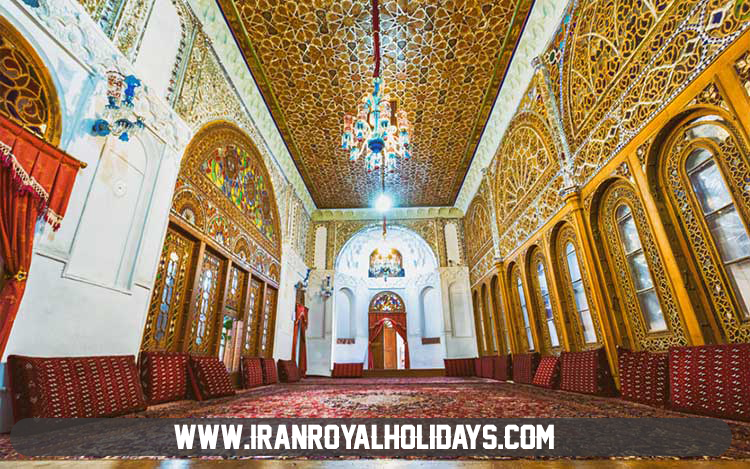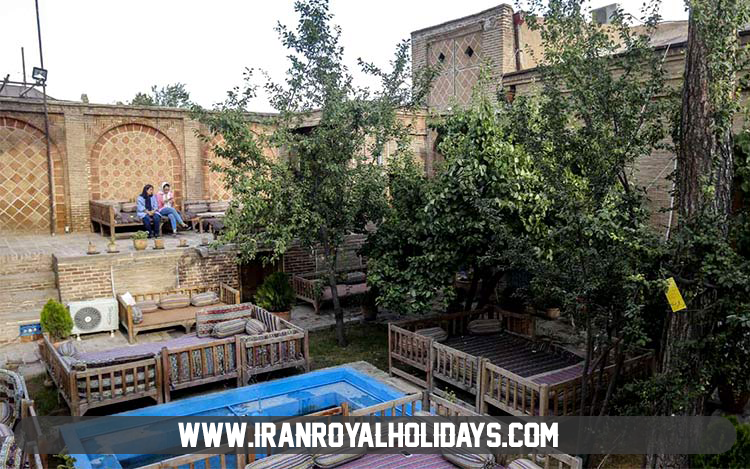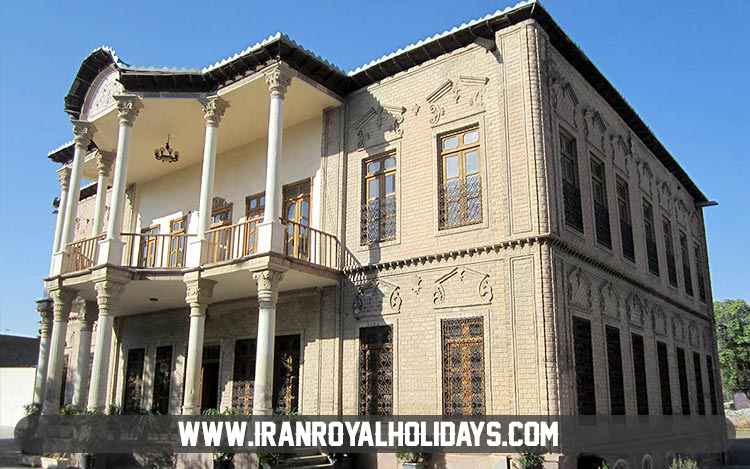Explore Iran and qajar era with Qazvin historical houses
Explore Iran and Qajar era with Qazvin historical houses
Qazvin is one of the provinces near Tehran which has a long history like other cities of our country. In this historic city, like cities like Kashan and Yazd, we see many historic houses and valuable buildings. Buildings that are part of our historical and cultural heritage are Iranians and we must strive to preserve this eternal heritage. Qazvin’s historic houses reflect the authentic Iranian architecture of various eras and the decorations are admirable. In this article, Iran Royal Holidays Tourism Magazine introduces historical monuments and introduces you to Qazvin’s tourist attractions. In a day trip from Tehran and neighboring provinces you can make your way to Qazvin and visit these houses on your itinerary.
In Qazvin province there are more than 100 historic houses that need restoration. People who have traveled to this city may have encountered traditional space-based resorts. The residences that were originally part of Qazvin’s historic houses have become attractive in the course of restoration. Let’s get acquainted with some of the city’s original and historic houses now.
The most magnificent house in Qazvin, Hosseinieh Amini
During the first Pahlavi dynasty, one of the Qazvin lords and traders, Haj Mohammad Reza Amini, built his house west of the Dezaj River. The river that today has become Rumi Street. The building is now one of Qazvin’s most spectacular and astonishing historic homes. A house built in the year 6 by great architects and artists. One of the most interesting pieces of design in this house is found in the halls. The three outer halls of the building are separated by long sashes. Easily assembled sashes create a space between these three halls.
All of these halls were covered with exquisite hand-made rugs. Elegant plaster decorations and colorful chandeliers decorate the room. During the mourning ceremonies, sashes were erected between the three halls and the courtyard to create an all-around atmosphere for the people. All the people would go to the Amini guest house during Muharram. As a result, the house became a hosseini for mourning and mourning.
Other parts of the house include the interior, the basement and the cellar, the barn and the barn. The house is now run by the descendants of Haji Mohammad Reza Amini. Although you cannot sit on antique carpets while visiting, it will still attract sashes and ornaments. You should go to Amini’s home and Husseiniyah with the prior coordination. So the best way to participate in Qazvin tours is.

Amini’s home address: Molavi Street
Khatibi House One of the largest historical houses in Qazvin
The name of Khatibi alley in Qazvin is taken from the name of a lodge inside it. The owner of the building was trusted by Haj Mullah Ahmad Khatibi, who was an ancestor of Nisar. This house with decorative brickwork in the backyard and an inscription of azure represents one of the Qajar and Pahlavi era houses. The house was designed by architects such as Professor Farajollah Architect, Master Asadullah Architect and Haj Ghulam Reza Architect.
Khatibi House is one of the largest historical houses in Qazvin with three courtyards with a three story building. Interior plastering along with the use of wooden sashes are signs of Qazvin architecture in this period. Today most of Khatibi’s space is abandoned and you may not be able to visit the building while traveling to Qazvin. According to Qazvin Cultural Heritage Plans, the house is set to become a beautiful residence in the coming years.
Qazvin Dai House Traditional market in historical context
One of the most fascinating monuments of Qazvin, now refurbished and used by the city’s Cultural Heritage Organization, is the Daii House. This home is a spectacular remnant of the Pahlavi era and has been able to maintain its vibrant day and day. You will find this monument as you walk through the historical context and when you reach the historic gate of the Koshak door. You can also buy your own souvenirs while visiting the two-storey building and its two rooms. The exterior of Da’i’s house is a brick courtyard with a veranda with wooden pillars and a stone base. This historic home is only 1.5 km to the city center.
Traditional hotel welfare house to stay in Qazvin
A unique example of the architecture of Qazvin’s historic houses with two basements and a ground floor is the Behrouzi House. This home has a central courtyard that is surrounded by other courtyards. The capability of this home, with its large rooms and beautiful summer and winter residences along with the porch, led to its restoration as a traditional residence. At this hotel you can live in rooms with arched ceilings and arches with beautiful arches for at least one day. Experience the same as you did in the past and travel on history. Brickwork decorations along with sashes are also characteristic of Qazvin’s historic home architecture.
Hotel Behrouzi was opened to tourists in the 12-room, 3-star hotel. It has good access to the old city texture and other Qazvin attractions like the bazaar. One of the good features of this hotel is the traditional marble bathroom. The live performance of traditional music on the porch and the wooden beds around the courtyard and the waterfront of the hotel provide an attractive living space for the guest. To book a hotel in Qazvin you can easily make your online shopping from Iran Royal Holidays.

Sayed Mahmoud Beheshti House, a spectacular home for architecture enthusiasts
For those who are architectural or architectural monuments in their field of study, we recommend visiting this house when traveling to Qazvin. Seyyed Mahmoud Beheshti’s house is one of the three-storey houses of the Qajar era. The house has a large interior and exterior, a formal vestibule, a beautiful corridor leading to the same vestibule and two courtyards. This house is located in one of Qazvin’s old neighborhood called Dimaj and you can easily find it from Molavi Street. This house is listed today in the National Archives of Iran with registration number 12605.
This house was owned by one of the famous sugar traders in Qazvin, Seyed Ahmad Beheshti. This person was one of the most important custodians in Qazvin who also built the tomb of the martyr. The house was named after one of its sons and now belongs to the Cultural Heritage.
House of Seyed Hossein Beheshti from Qajar era monuments
Qazvin historical houses can be called a house called Seyyed Hossein Beheshti. The house is located at the intersection of Ferdowsi and Municipal streets and has a wall adjacent to the street. From the west side with two equally sized entrances you can enter this house. The plan of this house is square and with a gable roof! The central and central porch covers the two floors of the building. This building and especially its north side wall have been refurbished to add to the beauty of Qazvin. The skylights are one of the main features of Seyyed Hossein Beheshti’s house.
The historic home of Dr. Asadi
The 100-year-old house is owned by a man named Haj Ali Asghar Asadi, near the house of Sayyid Mahmoud Beheshti. Haj Ali Asghar Asadi was one of the big businessmen in the city who built his own house in the Dimaj neighborhood. Another name for this house is Zainali. The porch has formal decorations and leads to the courtyard with a corridor. Entrance porch brickwork, colored stucco mirrors, colored glass sashes and courtyard brickwork are examples of Asadi’s home decor. The basement of the building with crescent arches and half-columns of brick indicates that we are facing a Qajar period.
House of Culture of Amir Kabir, a mansion you should definitely visit
Qazvin was a city for the presence of princes during the historical period of Qajar and Pahlavi and even before that, Safavid era. Amir Kabir House of Culture, named after Sardar Mokhofar’s mansion, is an in-garden building with views across the Qajar period. It has a two-storey stoneware and a window-filled building on two floors. The roof of the building also has a special elegance. The facade of each side of the mansion is different and the tall columns adorn it.
The spectacular monument was built by Prince Akbar Mirza, or Commander of the Muqtam (Evangelist Sultanate). Formerly used as an Amir Kabir school, it has now become the home of culture. The interior decorations of the building are also very spectacular and have become more prominent with prominent plaster casts. You can go to see Dr. Salehi’s donation museum.

And finally, Mortazavi’s house with six yards
Mortazavi is one of the other historic houses of Qazvin that has a large area of 1500 square meters. This Qajar house has six courtyards. You can see this monument in the exterior of Negini Shom, Hosseinieh Yard, North Hosseinieh Exterior Courtyard, Ostrich Courtyard and the interior and service areas of the house. The house is also located in Damaj district, Qazvin historical texture district.
If you have traveled to Qazvin City for stew food, be sure to write us in the comments and tell us about the monuments you have seen in this city.
Tags: historical iran, qajar era, qazvin hostorical house